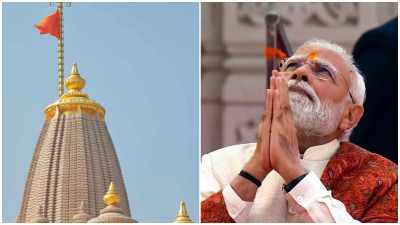PM Modi in Mumbai today to launch Atal Setu, India’s longest sea bridge
To get an idea of the scale of the project, the bridge was constructed using 170,000 tonnes of reinforced steel, enough to build 17 Eiffel Towers.
 The Mumbai Trans Harbour Link, formally named Atal Bihari Vajpayee Sewari-Nhava Sheva Atal Setu, starts from Mumbai’s Sewri and ends in Raigad of Navi Mumbai. (Express photo by Amit Chakravarty)
The Mumbai Trans Harbour Link, formally named Atal Bihari Vajpayee Sewari-Nhava Sheva Atal Setu, starts from Mumbai’s Sewri and ends in Raigad of Navi Mumbai. (Express photo by Amit Chakravarty)More than seven years after laying its foundation, Prime Minister Narendra Modi will inaugurate the 22-km Mumbai Trans Harbour Link (MTHL), the country’s longest sea bridge, during his day-long visit to Maharashtra on Friday.
Formally named ‘Atal Bihari Vajpayee Sewari-Nhava Sheva Atal Setu’, the bridge connects Sewri in Mumbai to Chirle in the state’s mainland district of Raigad at Navi Mumbai and is expected to cut travel time by around 45 minutes. Modi’s cavalcade is set to take this route to reach Panvel where he is scheduled to address a rally.
The two-carriageway, six-lane bridge — comprising a 16.5-km long sea link and 5.5 km land viaducts on the approach at both ends — was constructed at a cost of over Rs 21, 200 crore, including a loan of Rs 15,100 crore from the Japan International Cooperation Agency.
To get an idea of the scale of the project, the bridge was constructed using 170,000 tonnes of reinforced steel, enough to build 17 Eiffel Towers.
 The Mumbai Trans Harbour Link, or Atal Setu, ahead of the opening. (Express photo by Amit Chakravarty)
The Mumbai Trans Harbour Link, or Atal Setu, ahead of the opening. (Express photo by Amit Chakravarty)
Commuters using the bridge will have to pay Rs 250 toll per car, imposed by the Maharashtra government, for a one-way trip.
The Atal Setu aims to improve connectivity in the Mumbai Metropolitan Region, which comprises districts such as Mumbai, Thane, Palghar and Raigad, besides mitigating traffic congestion between Mumbai and Navi Mumbai and promoting regional economic development.
It is poised to provide faster access to both Mumbai International Airport and Navi Mumbai International Airport, besides enhancing connectivity between Mumbai Port and Jawaharlal Nehru Port. Furthermore, it is also expected to substantially reduce travel time from Mumbai to Alibaug, Pune, Goa, and the southern parts of the country.
The project was executed by the Mumbai Metropolitan Region Development Authority (MMRDA) on an Engineering Procurement Contract (EPC) basis. While PM Modi laid the foundation stone of the project in December 2016, work commenced in 2018.
The most arduous part of the project was the construction of the segments that lie in the marine portion, where engineers and workers had to dig as deep as 47 metres in the sea bed to provide strong foundations to hold up the massive girders and deck of the bridge.
The fact that the bridge lies close to sensitive establishments like ONGC, JNPT and BARC made the construction of these segments more difficult, with engineers having to take care they do not damage any underwater installations such as pipelines or communication cables.
While MMRDA and the project’s contractors sourced engineers and experts from across the globe, most of the labourers hired were from states such as Bihar, Orissa, Uttar Pradesh, Punjab and Maharashtra.
On an average, 5,403 individuals worked daily on the four packages of the project. According to reports submitted by the MMRDA, seven labourers were killed in six accidents during the project.
Meanwhile, during his visit to Mumbai, PM Modi will also be undertaking the Bhoomipujan (ground breaking ceremony) of projects like the Orange Gate-Marine Drive underground tunnel. He will also flag off the second phase of the Seawoods-Belapur-Uran train service and inaugurate the Digha railway station. Prior to his Mumbai engagements, the PM will be in Nashik to inaugurate the 27th National Youth Festival.







